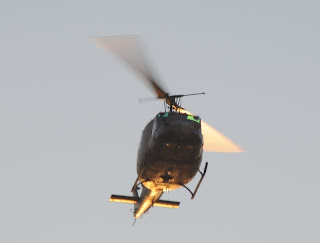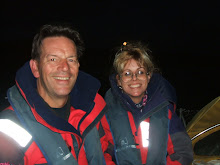We spent two nights on the dock at Gulluk, where we managed to find a new battery for the windlass, because the old one was getting very tired.
We were sitting quietly on the deck, playing backgammon and watching the world go by when all of a sudden one of the fishermen from the boat next-but-one to us brought over 5 fried fish, complete with a salad and slices of lemon. These fishermen were as good an advert for Gulluk as any tourism department. The fish were delicious, and later Gengis also gave us tea and biscuits. We took them some English Tea. I think the concept of putting milk into tea is too much for the average Turkish fisherman to cope with - they stuck to their Turkish version. We were even invited to go out that night fishing, but as our language barrier is set to maximum (i.e. we don't speak Turkish) and therefore the shout - "get out from under that crane" would have been lost on us. What I mean is that we thought it was too dangerous to go. However, they still get the 5 Star award for hospitality.
We moved onto Kuyucak, where the hotel was closed for the season, so that the bay that is normally full of windsurfers, dinghies and canoes etc. was completely calm.

We ended up in Guvercinlik, where we soon found that the place grew on us more and more. Yet again we found everyone to be pleasant and helpful. The change in season became more obvious here with some calm, misty mornings. We decided to photograph the scene as various objects came in and out of view, until the sun burned off the mist completely, leaving us with another very pleasant day.
One of the local restaurants was kind enough to fill our jerry cans with water, as well as giving us

complimentary coffees and teas - we tried to make sure that the tip box got something.
While we were there, several helicopters flew over us. In fact they few over 2 or three times, the on-board photographer decided that it was essential to have a photo that showed some movement of the rotors. It was a good job that there was more than one chance at it!
We caught a Dolmus to Bodrum, where we checked out the touristy sea-front and shopping areas. More remarkable was the huge indoor

market, which was full of fantastic fruit and veg, as well as every household item you never knew you needed.
Back in Guvercinlik, we had fun buying yacht varnish and sandpaper. This was not achieved however, without the shop owner giving us some bread sticks to munch on while we shopped.
All in all, Guvercinlik was one of those places that we could have stayed longer in. I guess that with it not being fully developed as a tourist destination it has retained a feel of the real and authentic Turkish coast.

We moved on after a few more days to Turk Buku, where we spent one night. This bay has been flooded with holiday developments, and I bet it bustles in the season, but at least here, unlike Gok, the development sits more happily in the bay, and it is not at all unpleasant. We moved on because it was not an ideal anchorage for the weather we expected. For some reason, like Gulluk, we failed to take any photos here.

 We came here on 20th November, and given that the wind is now blowing in excess of 20 knots, we will be staying till it drops. We are in the harbour that was once central to the ancient city of Myndos. There is not too much of it to see, apart from a few bits of wall, that are still visible here and there. We climbed the hill to try and find some remains, but instead found Deniz, and her friend with a kite. She was kind enough to lend us the kite, and take some photos. We were able to get a good view of Rabbit Island, which is in the entrance to the harbour. You can still see the old causeway that led out there, and it is good idea not to try sailing over it! On our way down the hill, we saw another tortoise, although this one was in the middle of lunch, and quite camera-shy.
We came here on 20th November, and given that the wind is now blowing in excess of 20 knots, we will be staying till it drops. We are in the harbour that was once central to the ancient city of Myndos. There is not too much of it to see, apart from a few bits of wall, that are still visible here and there. We climbed the hill to try and find some remains, but instead found Deniz, and her friend with a kite. She was kind enough to lend us the kite, and take some photos. We were able to get a good view of Rabbit Island, which is in the entrance to the harbour. You can still see the old causeway that led out there, and it is good idea not to try sailing over it! On our way down the hill, we saw another tortoise, although this one was in the middle of lunch, and quite camera-shy.


















